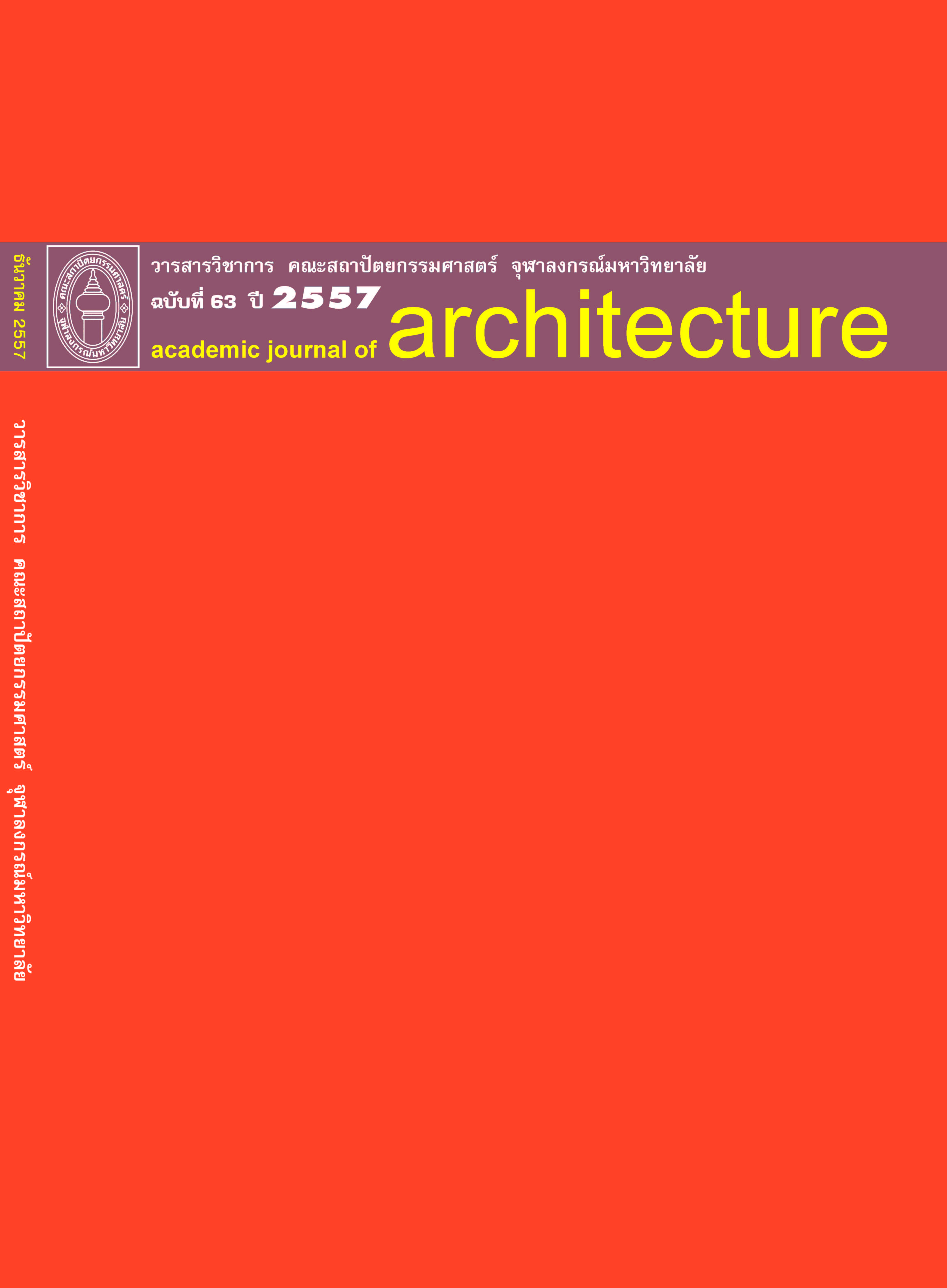Local Heritage Enclave within National Historic Settings: The Struggle of Wat Ratchanadda Community in Conservation
Main Article Content
Abstract
The old town of Bangkok, also known as Rattanakosin, has always been a remarkable conservation area, comprised of a series of heritage buildings with a fine-grained historical atmosphere. A number of tourism development plans and strategies have been designed by agencies local and national, in order to ensure Rattanakosin’s status quo as a popular tourist destination. However, as local enclaves set within the context of national heritage, the voices of several historic communities in the area have been overtaken by the grand historical-national narratives. Because they are not included as a part of grand historical-national discourse, some local communities are at risk, due to the influx of tourism, which is rapidly changing the authenticity of their settings. Through a case study of Wat Ratchanadda community, the authors try to examine the conservation process through the quasioperational academic field work conducted during April 2012 – March 2013 in order to encourage local people to maintain the survival of their own heritage. This research mainly aims to study the change in community conservation process via participatory approach, and to obtain knowledge of conservation through academic groundwork. Hence, the community conservation taskforce emerges, addressing four strategies: local historiography, building inventory, clustering conservation network, and defining community evelopment plan. The authors highlight three elements to envisage local heritage survivals: 1) ability to define the heritage value (art of articulating history), 2) degree and rigorous movement of allies in conservation, and 3) securing land tenure.
Article Details
References
ธนากร สวารักษ์. สัมภาษณ์โดยผู้เขียน. 14 มิถุนายน 2555.
ปราณี กลํ่าส้ม. “เมื่อวันวานที่ย่านถนนดินสอ.” เมืองโบราณ 27, 1 (ม.ค.-มี.ค. 2544): 122-131.
ยงธนิศร์ พิมลเสถียร. “ประเด็นวิกฤตเรื่องการอนุรักษ์ชุมชนประวัติศาสตร์ในเมือง.” หน้าจั่ว ว่าด้วยประวัติศาสตร์สถาปัตยกรรมและสถาปัตยกรรมไทย 9 (2556): 101-118.
สำนักงานคณะกรรมการพัฒนาการเศรษฐกิจและสังคมแห่งชาติ. โครงการศึกษาวิเคราะห์ เสนอแนะแนวทางการรักษา ฟื้นฟูและพัฒนา ย่านประวัติศาสตร์บริเวณพื้นที่ถนนราชดำเนินโดยการมีส่วนร่วมของชุมชน. กรุงเทพฯ: คณะกรรมการพัฒนาการเศรษฐกิจและสังคมแห่งชาติ,
2553.
สำนักผังเมืองกรุงเทพมหานคร. แผนที่ชุมชนกรุงรัตนโกสินทร์. กรุงเทพฯ: สำนักผังเมืองกรุงเทพมหานคร, 2547.
Ardrugsa, W. “Mount Sumeru’ and the New Thai Parliament House: The ‘State of Exception’ as a Paradigm of Architectural Practice.” Najua: Architectural History and Thai Architecture 10 (2013): 102-129.
Bettiol, C. “Architectural Preservation or Social Preservation?” Journal of the Faculty of Architecture, KMITL 5, 1(2007): 40-49.
Deleuze, G. and Guattari, F. Anti-Oedipus: Capitalism and Schizophrenia. Minnesota: The University of Minnesota Press, 1983.
Foucault, M. The Archeology of Knowledge. London: Routledge, 1972.
Hammami, F. “Conservation under Occupation: Conflictual Powers and Cultural Heritage Meanings.” Planning Theory and Practice 13,2 (2012): 233-256.
Harvey, D.C. “Heritage Pasts and Eritage Presents: Temporality, Meaning and the Scope of Heritage Studies.” International Journal of Heritage Studies 7, 4 (2001): 319-338.
Heathcott, J. “Heritage in Dynamic City: The Politics and Practice of Urban Conservation on the Swahili Coast.” International Journal of Urban and Regional Research 37, 1 (2013): 215-237.
Light, D. and Dumbraveanu-And one, D. “Heritage and National Identity: Exploring the Relationship in Romania.” International Journal of Heritage Studies 3, 1 (1997): 28-43.
Munasinghe, H. “The Politics of the Past: Constructing a National Identity through Heritage Conservation.” International Journal of Heritage Studies 11, 3 (2006): 251-260.
Mydland, L. and Grahn, W. “Identifying Heritage Values in Local Communities. ” International Journal of Heritage Studies 18, 6 (2012): 564-587.
Navapan, N. “Absolute Monarchy and the Development of Bangkok’s Urban Space.” Planning Perspective (2013): 1-24.
Pendlebury, j., Short, M., and While, A. “Urban World Heritage Site and the Problem of Authenticity.” Cities 26 (2009): 349-358.
Silverman, H. and Ruggles, F.D. Cultural Heritage and Human Rights. New York: Springer, 2007.
Sirisrisak, T. “Conservation of Bangkok Old Town.” Habitat International 33, 4 (2009): 405-411.
Tantinipankul, W. “Thailand’s Neglected Urban Heritage: Challenges for Preserving Cultural Landscape of Provincial Towns of Thailand.” International Journal of Tourism Anthropology 3, 2 (2013): 114-129.
Teo, P. “The Limits of Imagineering: A Case Study of Penang.” International Journal of Urban and Regional Research 27, 3 (2003): 545-563.
Usavagovitwong, N. “Labyrinth of Modernity.” ASA—Journal of Architecture 03 (2013): 90-97.
Vale, L. J. Architecture, Power, and National Identity. New Haven, CT.: Yale University Press, 1992.
Waterton, E. and Smith, L. “The Recognition and Misrecognition of Community Heritage.” International Journal of Heritage Studies 16, 1 (2010): 4-15.


